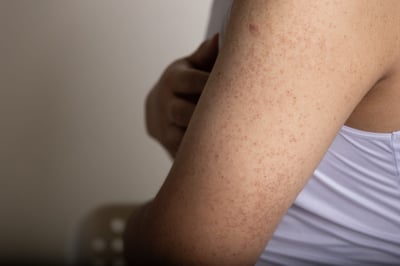
Strep throat and scarlet fever are caused by the same bacteria—Group A Streptococcus (GAS). While strep throat primarily affects the throat and tonsils, scarlet fever occurs when the bacteria produce a toxin that triggers a red, sandpaper-like rash. This toxin is responsible for the characteristic scarlet rash that defines scarlet fever.
The Relationship Between Strep Throat and Scarlet Fever
Strep throat is a bacterial infection that causes inflammation and pain in the throat. It’s common among children but can also affect adults. In some individuals, this strep infection progresses to scarlet fever, especially if the bacteria release certain toxins into the bloodstream. The key difference between the two conditions is the presence of a rash in scarlet fever. When an individual contracts strep throat, the bacteria may produce a toxin that circulates in the bloodstream and affects the skin. This leads to the scarlet fever rash, which usually begins on the chest and abdomen and eventually spreads to other areas like the neck, armpits, elbows, and groin. The rash typically feels like sandpaper, and the skin may peel off as the infection resolves.
Why Some People Develop a Rash
Not everyone with strep throat develops scarlet fever. The rash associated with scarlet fever appears in individuals who are more sensitive to the toxin produced by the strep bacteria. This sensitivity is what causes the immune system to react by producing the red, bumpy rash.
Signs of the Scarlet Fever Rash
The scarlet fever rash often begins within 24–48 hours of the initial strep throat symptoms, though in some cases it can appear later. Here’s what you can expect if scarlet fever develops:
- Color and Texture: The rash is red and may appear blotchy at first. As it spreads, it feels like sandpaper to the touch
- Pattern: The rash usually starts on the chest and abdomen before spreading to other areas of the body. The face may remain unaffected, but a flushed appearance is common, often with a pale ring around the mouth.
- Peeling Skin: As the infection begins to clear, the rash may cause peeling skin, especially on the fingertips and toes.
Why It’s Important to Seek Treatment
If left untreated, strep throat and scarlet fever can lead to serious complications. Rheumatic fever, kidney inflammation (glomerulonephritis), and ear infections are just a few potential risks. That’s why timely treatment with antibiotics is essential to prevent complications and minimize discomfort. It’s also important to complete the full course of antibiotics to ensure that the infection is fully cleared and to reduce the risk of spreading the bacteria to others.
If you or your child experiences a sore throat accompanied by a red rash, it’s essential to consult a healthcare provider for evaluation and proper treatment. To find a Forefront Dermatology office nearest you, please visit: https://forefrontdermatology.com/location/.





